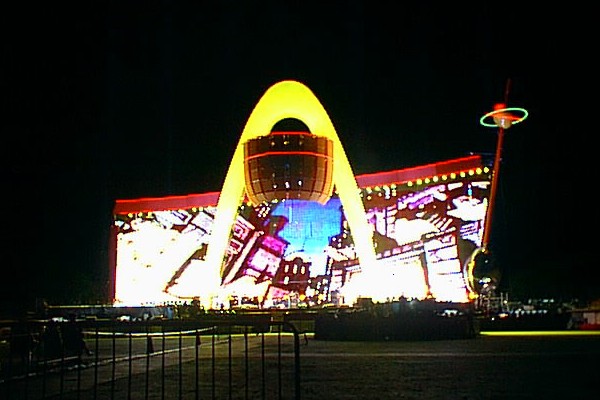Case Study
Analysis
of a glass reinforced plastic arch for a stage set
- Investigation into streses and
forces in GRP panels
- Assessment of wind loading
effects
- Tensioning of arch for lifting
process

Top architectural and engineering
consultants Atelier One used LUSAS Civil & Structural
analysis from FEA Ltd to help in the design of a self supporting
glass reinforced plastic (GRP)
arch - part of a 30m high structure forming part of the stage set
for one of the rock band U2's world tours.
For ease of transportation between
concerts the 7.8m high by 12m wide upper arch has to be constructed
from 40 separate GRP panels. Each 25mm thick panel is connected
vertically to its neighbour by 8 coffin latches for ease of
assembly. Steel base frames fit inside the lower 4 panels and a
central steel lifting frame fits into the top of the arch. Four
tensioned cables connect the top of the lifting frame to the base
frames and help to strengthen the arch during the lifting process.
After assembly horizontally on the ground, the arch is lifted into
position and fixed to the GRP-clad steel arch portal legs via the
base frames.
LUSAS was used to investigate
stresses and forces in the GRP panels and coffin latches caused by
the lifting process and, more critically, from a specified design
wind loading of 130kmh (80mph) where suction effects tended to pull
the joints between panels apart.
The
finite element model was created in LUSAS from DXF data supplied by
Atelier One's in-house CAD system. LUSAS QSL8 semiloof shell
elements modelled the GRP panels and JL46 joint elements were used
to model the coffin latches. The circular and rectangular hollow
steel sections of the lifting and base frames were modelled with
BSL4 beam elements. Self weight and wind loadcases were applied and
a linear static analysis obtained stresses in the GRP panels and
forces in the coffin latches for comparison with test results.
Independent tensile testing of the
coffin latches resulted in a breaking load of 2 tonnes being
achieved. By analysing the upper arch with LUSAS Civil &
Structural the force in the latch joints under the worst-case
loading condition was found to be in the order of 1.5 tonnes,
meeting the design requirements.
LUSAS was also used to study the
effects of increasing the tension in the 4 inner lifting cables that
connect the top of the lifting frame to the base frames. The aim of
this was to attempt to further reduce the overall forces in the
outermost latches by pulling the component panels together. By
applying an initial stress loading to the elements representing the
cables and repeating the analyses it was shown that due to the
geometry of the arch and the location of the cables that there was
no benefit in increasing the tension force beyond that initially
specified.
With
a tight design schedule to meet, dedicated engineers and the use of
LUSAS Civil & Structural software ensured that the
contract was completed in time for pre-tour stage assembly and
rehearsals.
|